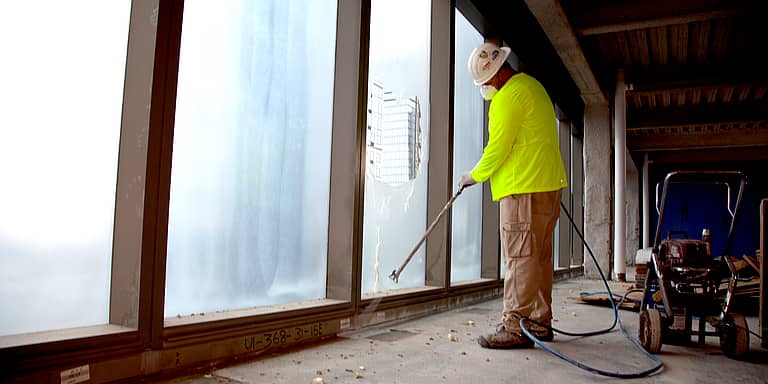Communicating with others is critical to the success of any company—especially for those in the construction industry. Architects, project managers, suppliers, employees all make up the diverse project team, and successfully communicating with each factors into the success—or failure—of a job. Learn how to navigate these relationships and communicate your message to each team member through various media to ensure that everyone is working together on a path toward success.
The combined knowledge and experience of AWCI members is a treasure trove of hard-earned wisdom. We reached out to some of them to mine that knowledge and experience in the field of communication so that we could pass it on in hopes that you will find some useful nuggets to further your own success and that of your company.
Internal Communication
We first asked about the best methods for improving communication with and among employees.
Shannon Davis, learning development lead, and Stacy Gunderson, craft training superintendent at Marek in Texas, put their heads together and came up with some well-considered answers to share: “The need to improve and strengthen communication with and among employees has always been on our radar here at Marek, and is even more prevalent now, given the state of our economy and the pandemic. Consistent communication across the board is one of the most crucial components. We have to have consistency amongst our leadership and aligned messaging and techniques to disseminate the messages. Additionally, if we do not have a process to maintain employee contact information, our efforts are irrelevant. It is also crucial to have a technology/platform to reach all employees in their preferred language (e.g., mass-texting solution). We have also found that surveying employees helps us uncover needs and provides topics we have to cover with our communication efforts.”
“Ultimately we’re trying to get the original message originating at the top of the company to cascade all the way to down to the lower levels without alteration,” says Sean Ledon, chief operating officer at California-based Daley’s Drywall. “We have found that the best way to do this is by email and then in-person to explain all the details. If you put too much in writing, people don’t read it. You need a written message to refer to, followed by in-person discussion so that the message doesn’t lose any of its meaning as it makes its way down.
“It’s very important when you relay information, to make sure the person receives it as intended,” continues Ledon. “A non-offensive comment such as, ‘Tell me how you understand these instructions,’ can save much trouble later. Then if you were not clear or the message was misunderstood, you can straighten it out right away. I try to take responsibility for making sure that the communication is understood all the way down the line. I’ll walk around the site and ask what they think of a new process we’ve instituted. If the message hasn’t communicated clearly, it can be clarified.”
Many factors contribute to excellent communication within the team.
“Over the last several years we’ve created a number of small groups inside our company covering key roles and processes such as project management, labor productivity and business development to name a few,” says Jim McCullough, director of business development at F.L. Crane & Sons in Mississippi. “These groups allow us to speak about key initiatives, current challenges and new ideas to improve each silo inside our company and business. Items discussed among these groups are then communicated by a trickle-down effect to their peers to help ensure everyone is aware of these items and the actions needed to achieve the desired results. We’ve seen a positive impact with these small groups, and it helps with company morale to involve everyone who plays an impactful role within each of the silos.”
Victor Roach, president of Western Partitions, Inc. (WPI) in Wilsonville, Oregon, stresses another key point: “You must first create an environment that allows your team to feel free to communicate about any subject without fear of reprisal. This also means handling sensitive subjects with decorum. If one of your team members is dropping the ball, he/she needs to be notified right away so that the problem doesn’t languish. But criticism or feedback is best done one-on-one, not in a group setting.”
Scott Turczynski, chief operations officer at Heartland Companies in Iowa, advises, “Know their preferred medium of communication. Some don’t review their email often enough to be timely. Some like quick, easy texts. Many prefer the old-fashioned phone call. Communicating to them in their preferred method will give you the best results.”
Communicating with the Wider Team
We then asked for recommendations for maintaining excellent communication with the broader team—architects, GCs, owners, project managers, suppliers, etc.
“We are really beginning to see a concerted effort among this group of people, including the owners, to promote and embrace the team concept,” says McCullough. “This helps facilitate many different things that contribute to a successful end-product for everyone involved. Through communication you begin to understand there is a level of consistency that can be achieved by the group as a whole to transition these relationships to true business partnerships that will help with future projects.”
Philip Ruffin, president of Pontiac Ceiling & Partition in Pontiac, Mich., notes, “With the increased use of online meetings/Zoom calls, we have found these to be more efficient as we are able to meet with a wider audience. Since travel is not required, these meetings are welcomed and, in many cases, become way more efficient than in-person conferences. However, our business is built on relationships. It’s very difficult to build a relationship over Zoom meetings, emails and texting. We need to visit our clients to continue to build these relationships.”
“Maintaining excellent communication with our broader connections/customers is crucial,” say Davis and Gunderson. “Depending on the purpose of the communication, we have found various methods to work: Providing company updates—newsletters, email blasts and social media platforms (Twitter, LinkedIn, Facebook) are all methods for pushing information out to the broader group. Providing project updates—utilization of technology platforms such as project-based software, as well as emails, phone calls and face-to-face interactions allow us to keep information flowing and current.”
“I don’t believe there is a one-size-fits-all method of communication,” says Roach. “Email is great for sending simple messages, standard communications and policies and procedures to small or large groups. For sensitive subject matter, or difficult issues with staff or clients, I feel face-to-face is still the best method. Other types of media, such as Zoom, work well for remote meetings. But again, I believe complex projects and analysis still require people together in a room. A phone call is still great for one-on-ones or joint call-ins about daily operations.”
Brenda Reicks, vice president at Tri-State Drywall LLC in Sioux City, Iowa, mentions some successful actions: “We post on our Facebook page and on LinkedIn. We sometimes send gift packages to architects and GCs. We have lunch meetings with GCs and occasionally have dinner with our project managers to show our appreciation.”
Bill Fritz, president/CEO of Mission Interiors Contracting, LLC in Texas, recommends “completely thought-out, encompassing emails with attachments that are directly to the point in order to minimize multitudes of emails. Try to phrase questions so that they require only a yes or no answer.”
There is always a need to keep a written record of many types of communication. Adam Barbee, estimator/project manager, at Daley’s Drywall in California, says, “The best means for communication is definitely email—it keeps a digital record of all history. It creates a digital bible. There are instances where you may work with an individual for several months or a year or more on a project. All of a sudden, that individual is no longer involved in the project. This puts you in a very difficult position. But you have built a failsafe within your emails for the enormous amount of information that puts the pieces together during a project.”
Pat Arrington, principal of Commercial Enterprises, Inc. in New Mexico, says the most difficult relationship to nurture is with “new, young professional architects and engineers. It is difficult to convince them that just because it’s on paper, it doesn’t mean it can be built that way.” His solution is face-to-face meetings. “Too many emails do not get the job done,” he says.
Communicating with the Workforce
Communication with the workforce is a subject all its own.
“There are a few challenges when communicating with a dispersed and diverse workforce: maintaining contact information, communicating in an employee’s preferred language, and helping employees adapt to new technologies,” say Davis and Gunderson.
Language can be a challenge.
Jerry Reicks Jr., president/CEO of State Drywall in Iowa, says, “Many of our craft people speak little English. Fortunately, our receptionist and most of our foremen are bilingual, and I can speak enough to put my point across and understand enough to know when they are not happy with me. My resolution for this is patience and respect.”
Fenya Slack, operations manager at Ivan’s Drywall and Painting, Inc. in Minnesota, says, “Our entire workforce uses text messages to give work assignments and uses pictures to better illustrate an issue or give more details on tasks. It’s very quick and simple. Everyone is very good at answering right away, because when we are in a build, we’re all expected to eliminate delays—and that includes delays of information.”
“We feel the best thing for our people is to set a cadence for the communication to happen through weekly team meetings, pre-, mid- and post-job reviews, along with performance reviews,” explains McCullough. “These meetings are valuable for us to discuss lessons learned, identify challenges and create action-items to overcome those challenges. They allow us to get everybody from the top down on the same page and create visibility for the goals we want to achieve.”
Fritz adds, “Consistency is key. Always communicate morning and afternoon at the same time—that way they expect it.”
Communication and Technology
It’s all too easy for the latest technology to overshadow the actual subject (communication) that it is there to facilitate.
As Barbee points out, “In the communication process, the importance of a human connection is absolute. So, phone calls, meet and greets, lunches and other face-to-face interaction make and complete the proper means of communication as a whole. We need to maintain the human aspect and keep technology as a tool.”
The various technologies available are of value if they improve communication, relationships, and productivity.
“We use a variety of communications,” says Roach. “We have in-person meetings, trainings and announcements. We use email, phone calls and Zoom meetings. We use our website, our intranet, Facebook, Twitter and LinkedIn. The only communication that isn’t useful is not communicating with your team, or too much communication. Try not to copy everyone on everything. People don’t have time to know what everyone is doing all the time.”
Ledon voices the preference of many of those interviewed: “One technology tool that stands out as particularly useful is email, especially as a follow-up communication. We have a great conversation with one of our clients but then always follow it up with an email so that the communication is clearly summarized. Sometimes, if the original communication wasn’t clear, the email exposes this and it can be clarified.”
The size and complexity of a company tends to dictate its communication needs in terms of processes, equipment, and training. Cathy L. Jordan, president of Spectro Construction, Inc. (SCI) in Florida, provides the perspective of a small company: “We are a very small company and the office personnel wear many different hats. We have developed relationships over the years with our GCs, subs, superintendents, foremen and crews that are established and consistent. We do not have the issues that a much bigger company may face. We try to use technology whenever possible (pictures/verbal and written communication), but frankly, we are a plastering company and work directly with plasterers and laborers.”
The latest technology and media are not a substitute for live communication. DeHorn makes the point: “Some issues just cannot be worked out over the internet, email or by texting. When employees comes to me and says, ‘I emailed him or her three days ago and have not heard back,’ I tell them it’s time to pick up the phone and have a real conversation.”
Training, Coaching and Other Education on Communication
There is no lack of training and education on the subject of communication available from specialized outside companies, as well as programs developed internally. What has proved effective?
“You have to find what’s right for your company that matches your culture, size, and level of sophistication,” advises Roach. “What works well for a 10-person shop may not for a 1,000-person shop. A small shop shouldn’t be spending a fortune on training and workshops when the basics will do for now. Don’t buy an expensive computer system designed for big companies if you aren’t big.”
Ledon enthusiastically details approaches that have proved workable at Daley’s Drywall. He says, “We use outside firms that specialize in training,” citing FMI, Fred Pryor Seminars and union training for foremen as examples. “We use any training available. We encourage it and don’t at any level discourage it. We also do a lot of coaching, and we have mentorships within the office management—almost everyone has a mentor. We also do periodic in-house training with certain levels of people.”
Some companies favor in-house training. Davis and Gunderson are among them: “We are currently working on creating various courses to help with communication platforms and technology to enhance our communication efforts. This eLearning will be available on our people platform, which is mobile friendly.”
Ruffin says, “We train internally on all aspects of communications. We feel when one of us can teach the rest, it’s received better than if we brought in outside coaches; and you always know you have to the coach for instant follow-up or resolution of an issue.”
McCullough mentions a specific angle on communication training that has proved useful at F.L. Crane & Sons: “We see value in the personality traits training available to help our workforce understand a few key items as they relate to communication. We want our people to have a clear understanding of how they typically communicate and how they like to receive communication during certain work-related situations. And we want them to understand how to recognize the way our customers would prefer to receive communication, based on their personality traits. When our employees understand this, they are able to avoid communication pitfalls and move conversations forward with minimal resistance.”
The Impact of COVID-19 on Communications
How is the current pandemic affecting communication, and what effective measures have been introduced to cope with it?
One obvious change is the shift toward virtual meetings and conversations. These have their pros and cons.
Ledon says, “Videoconferencing is doing the job, but no one is totally comfortable with it. Sometimes I fear the message is not being conveyed as well as it would be in person. We all prefer in-person meetings wherever possible. We have large conference rooms to permit social distancing. We do online meetings as much as we have to until we can get back to in-person.”
DeHorn, on the other hand, says, “Video conferencing has become a huge hit as a result of this pandemic. I think it will also replace having to drive to someone’s office to discuss something, especially in areas that have bad traffic problems. Another benefit of video conferencing is that it can be recorded and watched at a later time or be available to watch again in case something was not clear initially.”
The restrictions imposed by the pandemic have encouraged ingenuity and a variety of solutions to communication. Turczynski describes one solution at Heartland: “We have found that utilizing an Adobe Spark landing page works well. Whenever we add a video or letter, we text employees to tell them something has been added, and they can go and review.”
“For many employees, the biggest challenge to doing great work is understanding what that means for them in their role,” say Davis and Gunderson. “This is where effective communication becomes key to improving employee engagement. There needs to be a clear mission and vision that is communicated and remains consistent. Overall, don’t be afraid to be personal—get to know your employees, because they are your best resource.”
Ruffin sums up his thoughts: “Swift, efficient communications are our best tools. The world is fast, and we need not only to keep up with it, but to stay ahead of it and create or anticipate the next great need of our clients. Training and fast usage are the key to developing great communications.”
David C Phillips, a freelance writer and photographer, is an original founding partner at Words & Images.








